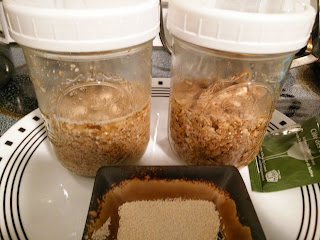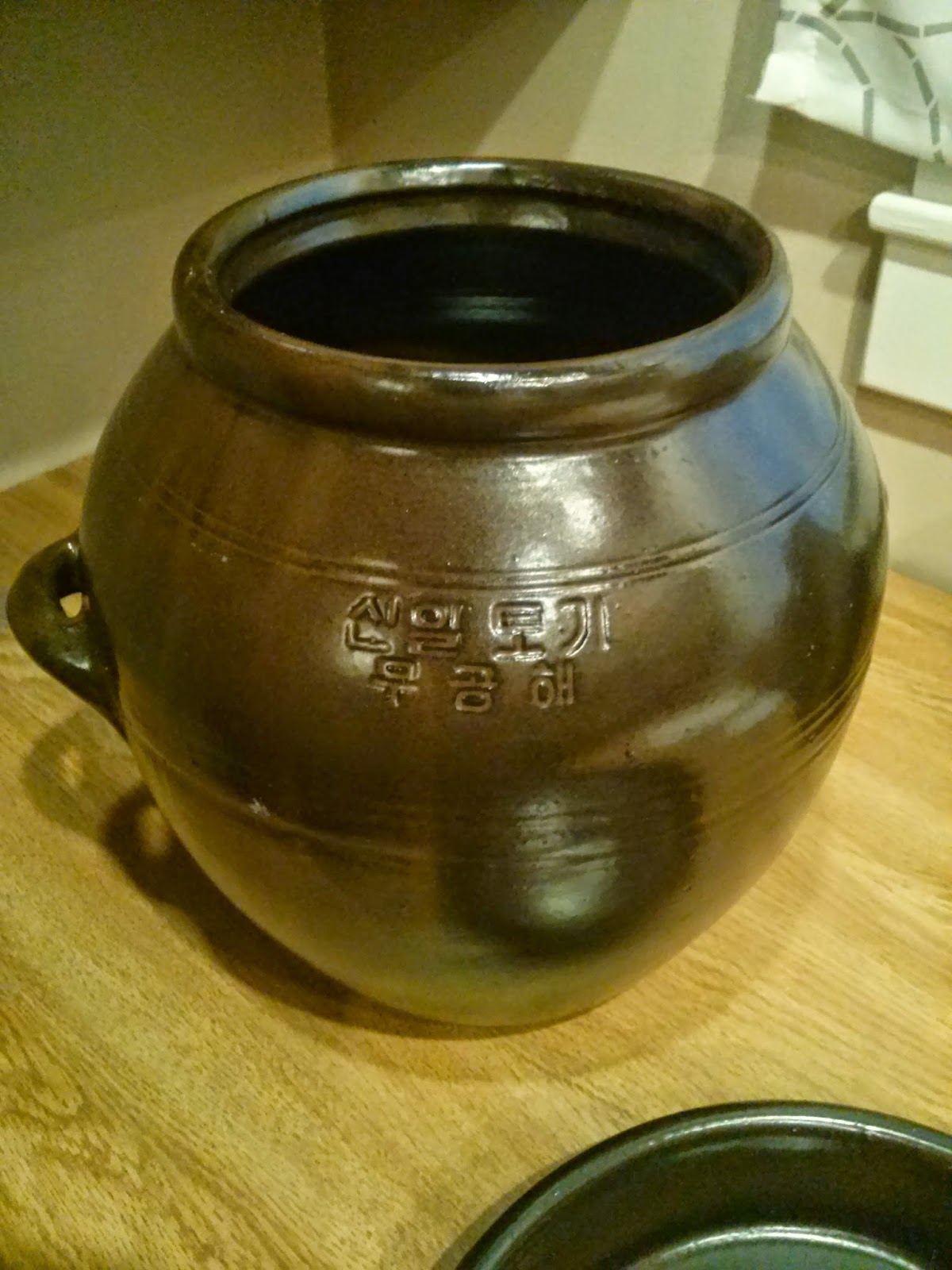Nuruk Comparison
Currently brewing is a comparison between two brands of nuruk: a "market" nuruk purchased stateside and an artisan nuruk produced in Busan.
Initial notes on the nuruk itself:
To review, nuruk is the fermentation starter used for makgeolli and other kinds of traditional Korean beverages. It consists of fermented grains or rice and is home to a diverse set of micro-organisms.
The "market" nuruk was purchased at H-Mart in the US under the brand Haeoreum. It has a pungent earthy aroma that is somewhat tangy on the nose. I would definitely describe the smell as moldy, but not foul or rank. It does not smell like decomposition. You may even describe the smell as reminiscent of a cellar or attic, but remember: no two smell alike. It definitely has an older scent than the Busan nuruk.
The Busan nuruk was acquired from a friend, and I don't think it is available to purchase in the US. The aroma is a combination of earthy and woody, but neutral. There is no tang and it is not as pungent as the market nuruk. If I could describe the scent using a common item I'd say clean cardboard. There is a definite hint of fungi, but it is much more subtle than the market nuruk.
The comparison:
Both brands of nuruk will be used in the same recipe, with the same ratios, made at the same time. The only variable will be the nurk. I will try to document differences such as smell, taste, fermentation progress, and any other noteworthy differences.
The starter is made with sweet rice flour, and the primary fermentation will take place using 1kg of white rice (mepssal) by making godu-bap.
Starter:
100 g sweet rice flour (찹쌀가루)
100 g nuruk
500 ml filtered water
2.5 g white wine yeast (Red Star)*
*I am using yeast for this recipe, because that is what I usually do when I make a starter. I will do another comparison in the future using only nuruk.
 |
| Nuruk samples soaking before use |
The market nuruk produced a more cloudy mixture, with some stubborn, hard clumps that refused to get soggy even after 2 hours of soaking. On average the particle size is smaller than that of the Busan nuruk, but the particles are very inconsistent.
The Busan nuruk primarily kept its shape while soaking, but the chunks were soft throughout and readily squished between two fingers. A number of very small rice beetles had floated to the top and were dispersed throughout the nuruk. This is harmless, but it is different from the market nuruk in this comparison. I have had market nuruk in the past with rice beetles, but that was only with the Choripdongi brand thus far. The particle size with the Busan nuruk was more consistent than the market nuruk, with chunks about as big as a fingernail.
 |
| Both starters after 24 hours. |
 |
| Closeup of starter with Busan nuruk. |
 |
| Closeup of starter with Market nuruk. |
The Primary Ferment:
1 kg Gyeonggi* white rice (경기 멥쌀)
100 g additional nuruk
1 L filtered water
*Gyeonggi is the brand of rice.
The godubap was steamed, 1 kg at a time, and added to each fermenter 500 g at a time for an even split between the two batches. It is situations like this that make me wish I bought an industrial steamer years ago!
The starter was then added to the godubap in each fermenter and mixed, then 1 liter of filtered water was added and mixed some more. The brews were stirred with a sterilized spoon for the first two days, and then left to their own devices.
Temperatures were pretty constant that week, which meant the temperature inside my cupboard where the brews were living stayed around 21 C (69 F). It went up to about 22 C inside the jars due to the fermentation process. At the end of the brew, the temperature sunk back down to 20-21 C, which was a good indicator of decreased yeast activity. On the 8th day, when the brew neared completion, I finally took some pictures.
There was still quite a bit of activity on day 8, so I decided to let the fermentation run its course.
On day 11, the activity had stopped or was slow enough to consider fermentation complete. The Market nuruk batch became slightly darker, which worried me that it might have gone on for too long, but the smell and taste were still quite good. Below is a side view of the market nuruk's fermentation jar with attached thermometer. The benefit of a glass container is you can see right through it, but you must remember to keep it covered or in a dark place out of direct sunlight.
1 kg Gyeonggi* white rice (경기 멥쌀)
100 g additional nuruk
1 L filtered water
*Gyeonggi is the brand of rice.
The godubap was steamed, 1 kg at a time, and added to each fermenter 500 g at a time for an even split between the two batches. It is situations like this that make me wish I bought an industrial steamer years ago!
The starter was then added to the godubap in each fermenter and mixed, then 1 liter of filtered water was added and mixed some more. The brews were stirred with a sterilized spoon for the first two days, and then left to their own devices.
Temperatures were pretty constant that week, which meant the temperature inside my cupboard where the brews were living stayed around 21 C (69 F). It went up to about 22 C inside the jars due to the fermentation process. At the end of the brew, the temperature sunk back down to 20-21 C, which was a good indicator of decreased yeast activity. On the 8th day, when the brew neared completion, I finally took some pictures.
 |
| Day 8 - Busan nuruk |
 |
| Day 8 - Market nuruk |
I'd like to point out the stark color difference between the two brews. The Busan nuruk is in the hangari and is much clearer than the Market nuruk. The smell is also more pure in my opinion. There seem to be less hints of the nuruk itself and more of an alcohol aroma. On the other hand, the Market nuruk still smells pungent in comparison, and the alcohol smells strong. Another note, I think the rice particles are more visible in the hangari due to the shape of the vessel. The glass container is a cylinder, while the hangari is wider at the top than the bottom, so I think the rice sits or floats differently inside each container; just a thought.
 |
| Day 11 - Busan nuruk |
 |
| Day 11 - Market nuruk |
 |
| Makgeolli with Busan nuruk on bottling day |
 |
| Makgeolli with Markey nuruk on bottling day |
Above you can see each brew as it looked on the scoop during bottling. What do you think? Do they look different?
 |
| From left: makgeolli with Busan nuruk, makgeolli with Market nuruk |
The fninshed product came out nicely. Both nuruks produced a makgeolli that I would be proud to serve; however, there were clear differences in taste. Please note the color differences in the picture above, too.
True to its smell, the Market nuruk's makgeolli was more of a pungent taste, with creamy, earthy flavors.
The Busan nuruk's makgeolli was much lighter on the tongue, but not because of alcohol content. I tasted citrus notes with some fragrance in the aftertaste.
Overall a great comparison. I would love to do this kind of side-by-side tasting again, so if you come across an interesting brand of nuruk, please let me know!
True to its smell, the Market nuruk's makgeolli was more of a pungent taste, with creamy, earthy flavors.
The Busan nuruk's makgeolli was much lighter on the tongue, but not because of alcohol content. I tasted citrus notes with some fragrance in the aftertaste.
Overall a great comparison. I would love to do this kind of side-by-side tasting again, so if you come across an interesting brand of nuruk, please let me know!



Comments
Post a Comment